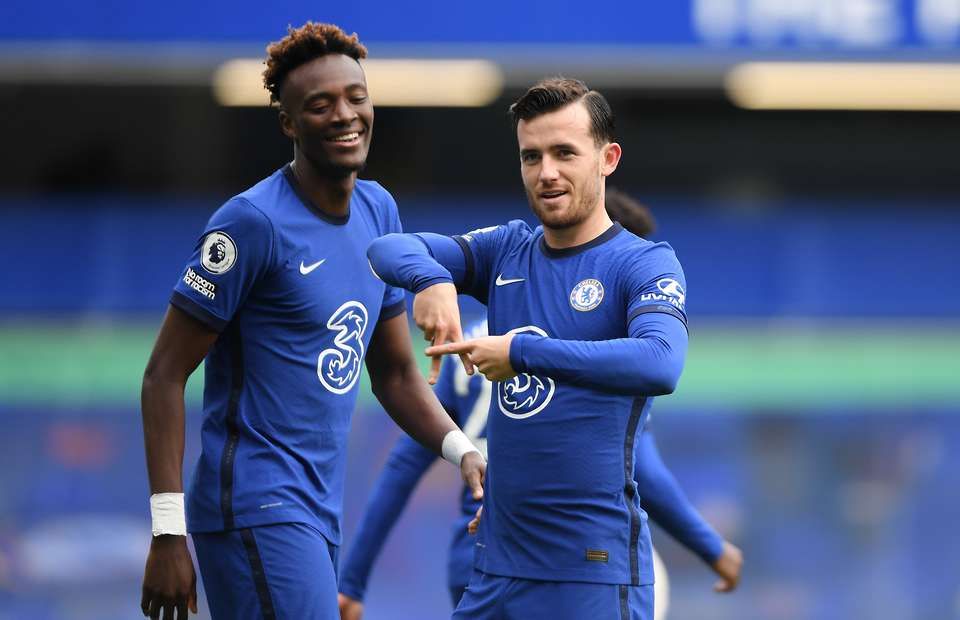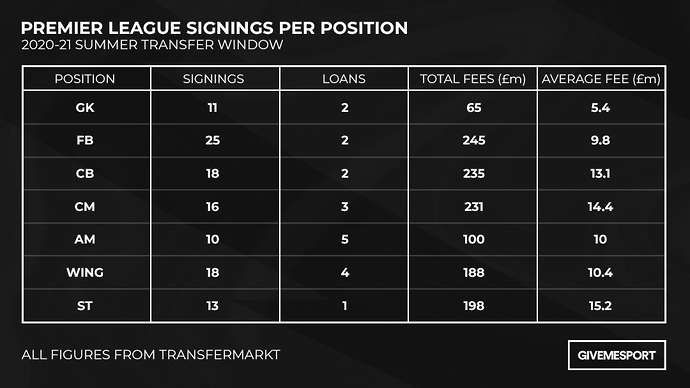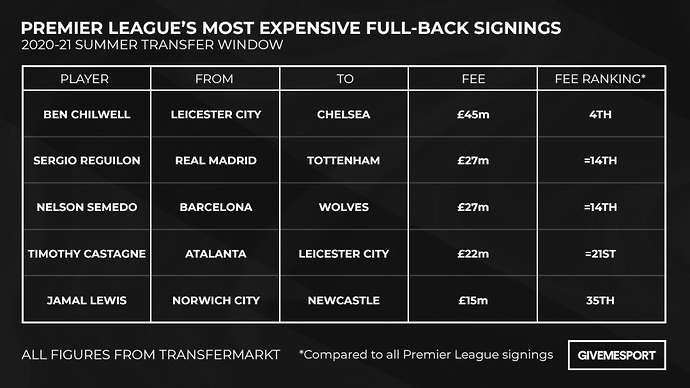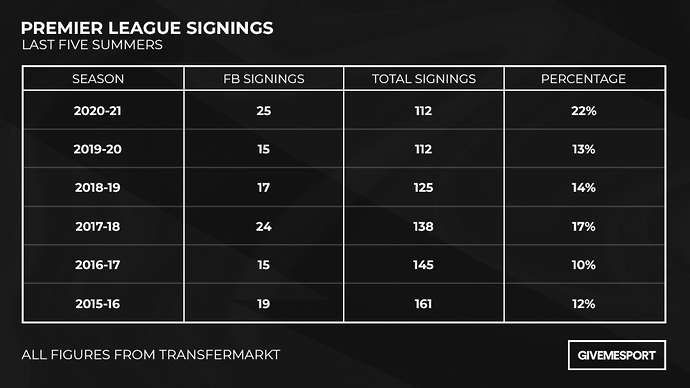It is the perceived wisdom in football that the attacking players in any team are the most significant, the most decisive and therefore the most valuable, but the Premier League’s recruitment during the 2020 summer transfer window juxtaposes that notion.
Whilst the most money on average was spent on strikers, with just over £15m forked out per acquisition, it was actually the positions further down the pitch that saw the most deals done and the most money spent - all figures courtesy of Transfermarkt (with rounding up).
Collectively, £37m more was spent on centre-backs than strikers during the transfer window, while even with Chelsea committing the biggest single sum of the summer on their new No.10 Kai Havertz, attacking midfielders (£10m) on average cost less than central defenders (£13.1m) and central midfielders (£14.4m), as Premier League clubs curiously signed as many attacking midfielders on loan as they did in permanent deals.
But the most significant trend, which is symptomatic of how drastically the game has changed in recent years, comes on the defensive flanks. While Premier League clubs spent the second lowest amount on them on average, full-backs were the most frequently recruited players during the summer and were therefore responsible for the largest total spend - £245m.
As ever with statistics, there is a slight caveat here, because both sides of the defence have been grouped together, widening the net players are categorised under compared to other positions. But the same can be said for wingers who were counted indiscriminate of what side of the pitch they occupy, while our central midfielder bracket also included defensive midfielders too.
Further crushing the notion of statistical hoodwinking is how the number of full-back acquisitions has noticeably increased compared to previous summer transfer windows. This summer saw 25 full-backs signed, which is the highest total in the last six years and equalled 22% of the Premier League’s overall 112 arrivals in all positions. The second-highest ratio in that period was just 17% during the summer prior to the 2017/18 season, while the transfer window just gone also witnessed a 9% increase on the number of full-backs signed last year in comparison to all signings.
Tellingly, every member of the Premier League’s Big Six signed at least one full-back this summer - albeit in some instances being for the future rather than this season - while Sheffield United brought in one for each flank, Fulham acquired three and Wolves brought in a whole new quartet.
In fact, all but three Premier League clubs signed a full-back of some description - be it on loan or permanently, for now or for campaigns ahead - and of the 17 clubs who did bolster their defensive flanks, five swooped for more than one. Three full-backs - Ben Chilwell, Sergio Reguilon and Nelson Semedo - ended up in the top 15 most expensive signings of the summer, while five made the top 35.
So why has there been such an elevated emphasis on full-backs this summer, why have so many clubs recruited more than one, and why have some commanded such lofty transfer fees? Well, it is without doubt the position that has seen the most change in recent years and whereas modern, attacking full-backs were not long ago deemed a welcome luxury, they have now become essential at every level of the Premier League barring a few old-school exceptions (see Phil Bardsley at Burnley).
Pep Guardiola and Jurgen Klopp’s tactical setups are perhaps most synonymous with using full-backs like Kyle Walker, Trent Alexander-Arnold and Andrew Robertson who in prior generations would have been seen as out-and-out wingers, using their speed and offensive quality to provide the width in attack, but the transition started arguably before that when Antonio Conte brought his 3-4-3 formation to Chelsea.
As the system was quickly adopted throughout the Premier League - since becoming the go-to Plan B for top sides upon facing particularly weak, particularly strong or particularly tricky opponents - the emphasis on full-backs suddenly changed. More defensive-minded ones were made redundant in favour of those who could operate both as part of a back four and in more advanced wing-back positions, where energy and attacking threat would be as important - if not more so - than defensive nous. That desire for tactical flexibility has been as significant as Guardiola and Klopp’s styles of football in transforming the expectations of modern full-backs.
While that explains why full-backs have seemingly gained new significance in the transfer market, it still doesn’t quite uncover what’s so special about this summer’s transfer window in particular. After all, Conte left the Premier League two years ago and it’s been three years since Guardiola won his first title at Man City. We’ve known about the evolution of full-backs for some time - so why the sudden influx now?
It’s important to remember - as if it’s impossible to forget - that European football is amid its most testing time since World War 2, and the global pandemic has notably affected spending power in the transfer market. The transfer window just passed represented the Premier League’s lowest collective summer outlay in four years, and just two players - Havertz and Ruben Diaz - entered the Premier League’s 21 most expensive signings of all time. The past three seasons (albeit the January window included) had five entries each.
So perhaps clubs and managers felt acquiring new full-backs was a more cost-effective means of refreshing the dynamics of their teams, over spending big on the attacking players who’d traditionally be seen as signings to revolutionise a club’s playing style. That’s also reflected in the weighting of loans against permanent signings for attacking midfielders and wingers, suggesting clubs have by and large resisted taking traditionally costly risks on new offensive players, instead seemingly favouring changes lower down the pitch.
Recent history suggests they might be onto something, because over the last five years there has been a clear correlation between changing full-back personnel and trophies at the top end of the Premier League. Guardiola brought in Walker, Mendy and Danilo (while also remoulding Oleksandr Zinchenko and Fabian Delph into left-backs) the summer before Manchester City won their first title under him, Liverpool’s European and domestic titles were only won after Andrew Robertson and Trent Alexander-Arnold had become well-established members of the starting XI, and Conte signed a wing-back in Marcos Alonso and converted Victor Moses into another as his 3-4-3 setup led the Blues to the Premier League crown.
And while it doesn’t quite fit the narrative of future champions bringing in attack-minded full-backs, even Claudio Ranieri only turned Leicester City into machine-like title winners after he added Danny Simpson and Christian Fuchs to his starting XI in gameweek 10, having started the campaign with Ritchie De Laet and Jeffrey Schlupp. Before that, the Foxes’ win rate in the league was just 44% - from then on, it jumped up to 65%.
Indeed, it seems that full-backs have become instrumental in defining the balance of a side, in providing the dynamics to build a game-plan around and ultimately to quickly remodel the style of a team. That only rings doubly true during a period in which big-money attacking signings are either financially out of reach or at the very least seen as a significant risk.
But it must be remembered that footballing philosophies and tactics operate in cycles, reacting to whatever new conundrum the latest revolutions have thrown up. So while full-backs may currently be enjoying the peak of their importance in the Premier League, the real question is which position will be the next to evolve to counteract how they operate, and which managers will be smart enough to make them the most sought-after players in the transfer windows to come?























